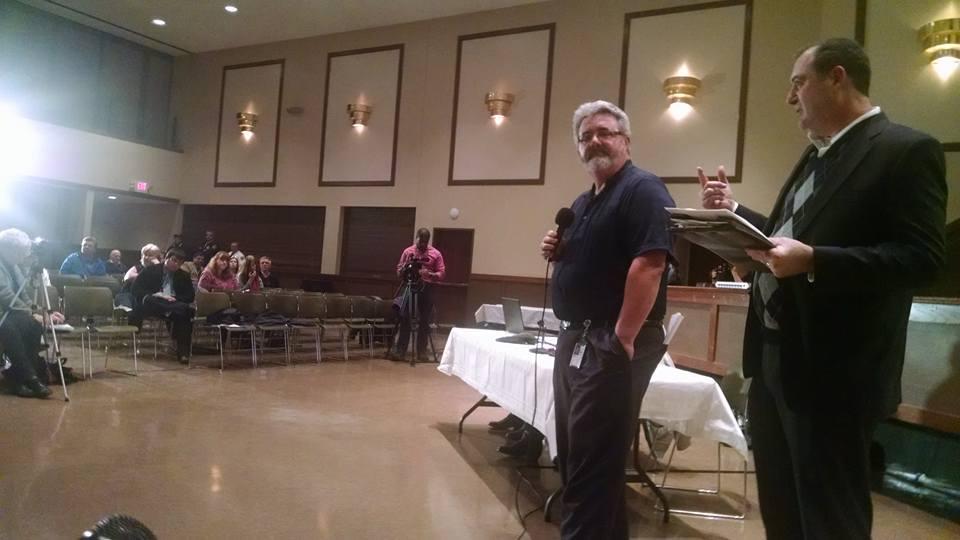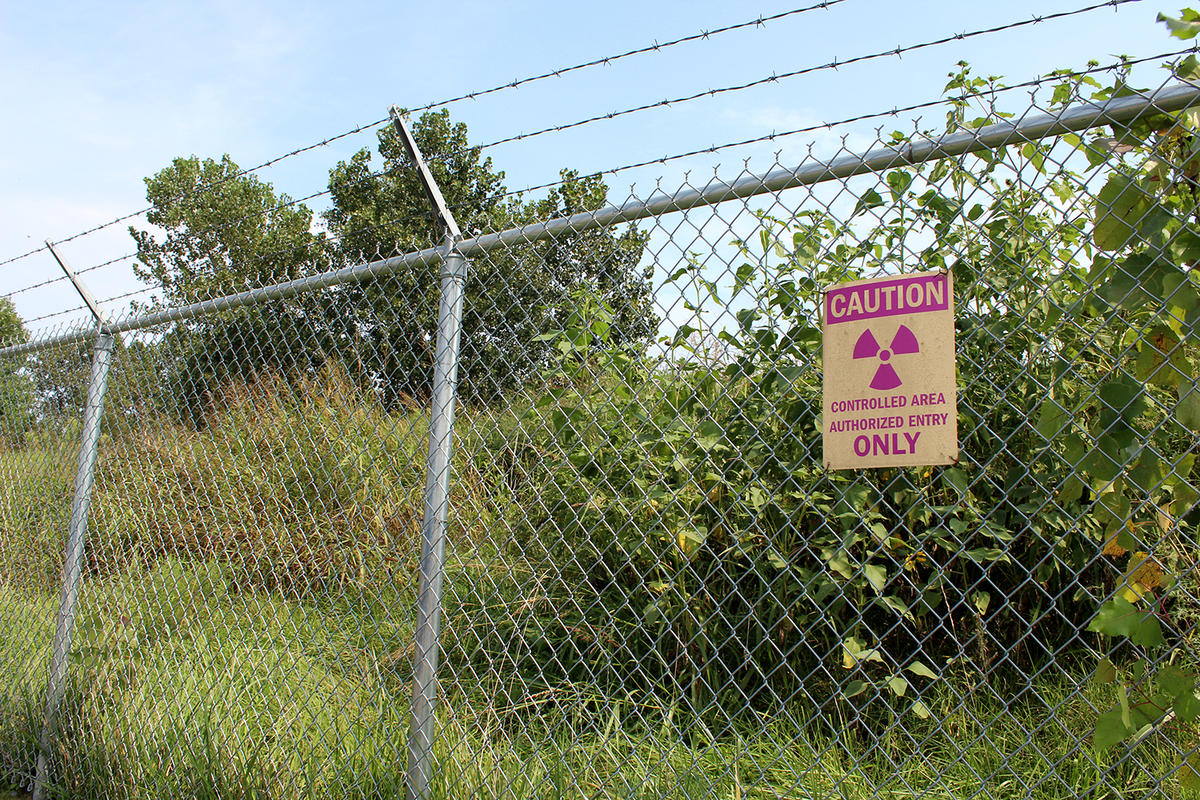St. Louis Public Radio
by Stephanie Lecci
In a move that environmental groups say they are “excited” and “pleasantly surprised” about, the Environmental Protection Agency said it plans to create a specific unit to study groundwater contamination at the West Lake Landfill Superfund site.
At a meeting of the West Lake/Bridgeton Landfill Community Advisory GroupMonday night, the EPA also said it would conduct more testing to see if any radiological sediment had moved off the site during widespread flooding last year.
It further described methods it is developing to determine what might happen if an underground fire smoldering at the nearby Bridgeton Landfill were to spread to reach the World War II-era nuclear weapons waste stored at West Lake Landfill.
Third unit
Currently, the EPA oversees the remediation of the two areas, or operable units, at the West Lake Landfill Superfund site. After first considering the idea a year ago, the EPA now wants to add a third operable unit, or OU3, to study radiological levels in groundwater under the site.
That investigation would conclude with a clean-up plan to be paid for by the “potentially responsible parties,” including landfill owner Republic Services and the Cotter Corporation, said Brad Vann, remedial project manager for the EPA Region 7. Vann said previous studies showed higher than acceptable levels of radium in the groundwater within the site, but earlier data couldn’t determine how much of that leachate came from typical landfill waste, naturally occurring radium or from the radiological waste.
“We’re going to try to launch that this year, along with everything else we’re doing, and then there will be an RI – a remedial investigation – and a feasibility study will follow, and then its own ‘record of decision,’” Vann said.
Representatives from the Agency for Toxic Substances and Disease Registry assured residents at an October meeting that any groundwater contamination would not affect human health because no nearby private wells were being used primarily for drinking.
Monday’s announcement was welcome news to many residents.
“The EPA actually voluntarily decided to create an OU3 to handle groundwater contamination, which they cited exists, and they want to basically come up with a remedy to clean the groundwater,” said Community Advisory Group chairman Doug Clemens. “We were all pleasantly surprised to hear this because the potential of leaching into the Missouri River, which is our drinking water supply, is there. We want to make sure nothing is getting into our drinking water supply.”
For Ed Smith of the Missouri Coalition for the Environment, creating a third unit at the Superfund site would mean “accountability – making sure somebody would pay for clean-up.”
“We’re actually excited that the EPA is going to look into it,” he said.
The announcement also comes shortly after the U.S. Senate passed a bipartisan bill that would transfer the authority over remediation from the EPA to the Army Corps of Engineers. Missouri’s Congressional delegation and many residents have called for such a change, saying the EPA has long delayed implementing clean-up. The bill now goes to the House.
Sediment testing
The EPA will also take soil samples of sediment around the site “specifically in response” to flooding throughout the St. Louis region prior to New Year’s. Even though Vann said there was “clearly runoff from the site,” the EPA doesn’t believe that included sediment from landfill areas with nuclear waste.
Still, Vann said sediment samples hadn’t been taken in a number of years, and the Missouri Department of Natural Resources was concerned that sediment near radiological materials needed testing.
As a result, Vann said the agency will collect and analyze samples from several sites and locations tested by the Department of Natural Resources back in November. That includes two spots on the nebulous border of the landfill and two private businesses, in what’s considered a buffer zone, where the MDNR’s preliminary report released last month found radiological material.
Vann said the EPA will also test drainage ditches.
“If there was going to be runoff from areas one and two, we’d find sediment there,” he said.
Potentially contaminated runoff was an issue for the members of the CAG.
“The EPA has actually responded to a number of our concerns,” Clemens said. “The fact that more testing is happening and we’re seeing the results of those tests is really a nice thing for us to see.”
Concerns about fire break
Despite the promise of more testing, some residents at the meeting said the EPA is still not doing enough. Tonya Mason of Spanish Village said the EPA should conduct testing in a grid pattern, rather than a “step-out method” – moving outward from an area known to contain radiological material until none is found.
“You can’t find it unless you test,” she said. Vann said the EPA has used an “overlay grid” to sample at the two areas at West Lake Landfill in the past.
But Mason said she was concerned that no testing had been done on soil from Bridgeton Landfill’s south quarry, with its underground fire.
“If it’s currently burning, why wouldn’t you test it? To me, as a resident, I feel like you’re afraid of the answer,” she said.
But Vann said the history of the site and other analyses, including testing air samples above the quarry for gamma radiation, have indicated there’s no radioactive material there.
Mason also questioned the EPA’s plan for an isolation barrier, officially announced in December, to prevent the underground smoldering from reaching radiologically impacted material (RIM).
“What are you barrier-ing it from? Because if the RIM is already where there is fire, then the barrier means nothing,” she said.
Vann said the EPA plans to go ahead with requiring the fire break be built. But he said the EPA is testing to see what happens to radioactive samples from the landfill site at increasingly high temperatures, of up to 482 degrees F. He said that’s hotter than temperatures recorded near the smolder.
“What happens? Does it give off gas? Change phase – does it move from a solid phase to gaseous (or) liquid?” he said.
So far, only a solid phase testing has begun; Vann said liquid and gas tests are being developed.
Capping the soil
Meanwhile, Vann said the EPA is also working to get those responsible for the landfill to deploy a “noncombustible cover” on the areas with surface-level radiological material.
That’s because a small fire broke out last fall on the surface of West Lake Landfill. The incident sparked concerns from first responders and residents about the possibility of a ground fire reaching contaminated soil.
Vann said brush will be cleared, chipped on site, and buried before affected areas are covered with matting. He said surface-level gamma scans will also look for spots that might have been missed in previous testing.
Vann said the cover will not only help reduce surface fires, but also prevent contaminated soil from washing away in the event of future flooding.
It will also stop wind from blowing away radioactive surface soil. November’s MDNR interim report had found one radiological dust sample in that buffer zone on the boundary of the landfill.


